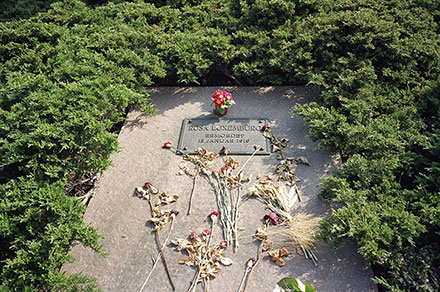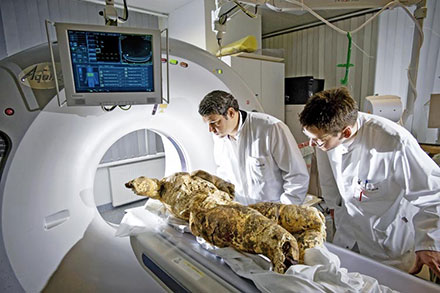 |
 |
 |
‘On the empty tomb of Rosa Luxemburg and Walter Benjamin’s critique of violence’, abstract by Anthony Auerbach. The project outlined below stems from my informal paper
on Benjamin’s ‘Critique of Violence‘ and my research for Aerial Reconnaissance Berlin as part of the International Necronautical Society’s Inspectorate in Berlin. It was prompted by the conference Aesthetik der Gewalt organised by Anna Pawlak and Kerstin Schankweiler at the Kunsthistorisches Institut of the Universität zu Köln, 11-12 Jul 2009 and is supposed to appear in the Tagungsband.

 Walter
Benjamin’s ‘Zur Kritik der
Gewalt’ [note 1]
appears to be an anomaly for
an author best known for his
aesthetic writings. The article
could have seemed even more incongruous
to readers immersed in the ‘contemporary
European conditions’ [note
2] whose tumult
is barely acknowledged in the
text, but whose resonance would
hardly have needed amplifying
in 1921. Recent commentaries
have affirmed the abstract, esoteric
(even prophetic) aspects of Benjamin’s
essay, while the historical context
in which it was written has faded. Walter
Benjamin’s ‘Zur Kritik der
Gewalt’ [note 1]
appears to be an anomaly for
an author best known for his
aesthetic writings. The article
could have seemed even more incongruous
to readers immersed in the ‘contemporary
European conditions’ [note
2] whose tumult
is barely acknowledged in the
text, but whose resonance would
hardly have needed amplifying
in 1921. Recent commentaries
have affirmed the abstract, esoteric
(even prophetic) aspects of Benjamin’s
essay, while the historical context
in which it was written has faded.
Painting the broad historical canvas of Germany
in the years following the First
World War would certainly highlight the violence
of the political and social struggles which
erupted when the old regime quit the scene.
But such a picture, sensational though it may
be, would not amount to a reading of Benjamin’s ‘Kritik’.
For a critique of the aesthetics of violence — that
is to say, a critique of the entanglement of
violence and its representations — I propose
a different history, working backwards from
a present particular of our own contemporary
conditions as readers, to intersect with Benjamin’s
as a writer.

The empty granite sarcophagus inscribed for
Rosa Luxemburg in Berlin’s Zentralfriedhof
is one of several funeral sites
from which her body has absconded.
The Gendenkstätte
der Sozialisten [note 3],
like the monument not far away
which announces ‘Auf
diesem Fundament stand das Revolutionsdenkmal’ [note
4] — and
the Revolutionsdenkmal itself
[note 5],
which stood at the site where
Luxemburg’s
empty coffin was first buried
in 1919 [note 6] — is
an iteration of a cult that compels
repetition, not revolution.
There might be some irony in such a cult arising
from the lost remains of a political incendiary
whose own reflections on violence anticipated
something different. But it was Luxemburg’s
violent death rather than her literary or political
legacy that secured her after-life as martyr
and icon. The compulsion associated with her
empty tomb suggests the force Benjamin characterised
as ‘mythic’ that binds violence
to repetition and dooms revolution from the
start. Benjamin’s critique moreover prompts
a reassessment of Luxemburg’s theory of
violence to which it may already be indebted.
What Luxemburg and Benjamin seem to share is
shaped not by a critique of violence per se,
but by their opposition to the war of 1914–18
and a critique of the romantic and idealist
aesthetics that supported it.
 ‘Remarks
on Walter Benjamin’s Critique of Violence’ ... ‘Remarks
on Walter Benjamin’s Critique of Violence’ ...
 Aerial
Reconnaissance Berlin... Aerial
Reconnaissance Berlin...
 ...
return: On theory ...
return: On theory
 ...
return: Urban matters ...
return: Urban matters
Notes
- Archiv für Sozialwissenschaft und Sozialpolitik,
47 (1920/21), pp. 809–832. [back
to text]
- ‘Critique
of Violence’ (1921), trans by. Edmund
Jephcott, in Walter Benjamin, Selected
Writings Volume I 1913–1926 (Cambridge,
MA and London: Belknap Press/Harvard University
Press, 1996), p. 238. [back to
text]
- 1951. The design of the complex
is due to DDR President Wilhelm Pieck (1876–1960)
who in 1919 had escaped the fate
of his comrades. He is also buried at the centre
of the site. Wie Man sich bettet, so liegt Man.
[back to text]
- Günter
Stahn (architect) and Gerhard
Thieme (sculptor), 1983.
[back to text]
- Commissioned
from the architect Ludwig Mies van der Rohe
for the KPD by Eduard Fuchs 1924, dedicated
1926, defaced 1933, destroyed 1935.
[back to text]
- The first funeral took place on 25 January
1919, ten days after the murders of Liebknecht
and Luxemburg. In March 1919 the body of Leo
Jogisches was laid to rest next to the empty
coffin of his former comrade and partner. In
May, Luxemburg’s body was recovered from
where it was dumped, and on 13 June was buried
with ceremony. In the following years, the bodies
of more dead Communists were added and after
1924, annual ‘LLL-Feiern’ (Liebknecht-Luxemburg-Lenin
commemorations) were instituted by the party
every 15 January. The body could not be found when the Gendenkstätte
der Sozialisten was instituted
after the Second World War. Instead, earth
from the former burial site was enclosed in
the new tomb. [back to text]

Additional note: In May
2009, after I had drafted this
abstract, the pathologist Michael
Tsokos, Professor of Forensic
Medicine at Berlin’s
Charité University
Hospital, announced that the
remains of an unidentified
body preserved in the basement
of the hospital are probably
those of Rosa Luxemburg. Medical
examination of the headless
corpse without hands or feet,
and the discovery of inconsistencies
in the autopsy report of the
body released for burial under
Luxemburg’s
name in the summer of 1919,
suggested that the body fished
from the canal, which supposedly
filled her previously buried,
empty coffin, and which could
not be found after the site
was razed in 1935, was not
hers. The identification of
the Charité body,
should it be proven (the pathologist
would like to perform a DNA
test to compare the remains with a sample
from a living relative, although he admits
this would only provide a probabilty, not
a certain identification), would further suggest
that Luxemburg is likely to receive another
burial, that is, if the saintly qualities
with which her memory has been
invested do not demand a monstrance,
which would tend, in turn,
to affirm the heroic qualities
invested in the torso.
[back to text]
Images
Changing of the guard: troops in the streets of Berlin
during the withdrawal of Freikorps militia that
supported the ‘Kapp Putsch’ of March
1920 (picture postcard, collection: AA).
The tomb of Rosa Luxemburg where no body was reburied in 1951 (photograph: AA).
Photograph issued by the press
office of Berlin’s Charité Hospital
showing Michael
Tsokos and an unidentified
pathologist posing with the
remains supposed to be of
Rosa Luxemburg.
|
 |
 |
 |
 |
 |